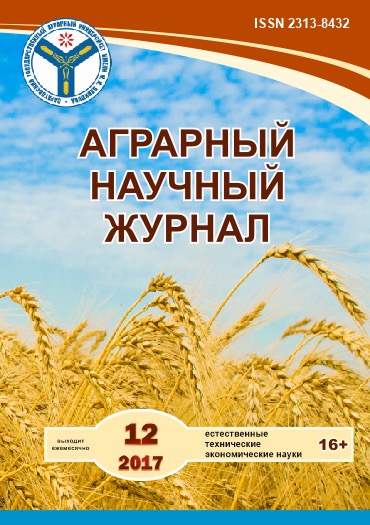THE EFFECT OF A SUCROSE CONCENTRATION DECLINE ON THE EMBRYOIDOGENESIS IN MAIZE UNPOLLINATED OVARY CULTURE
Keywords:
in vitro, haploids, maize, unpollinated ovaries, sucrose, embryoidsAbstract
The effect of sucrose concentration decline in the nutrient medium
was investigated for optimizing of the maize haploid production
in a culture of unpollinated ovaries. The explants donors were
one apomictic and six amphimictic lines. Ovaries were transferred
from the initial medium (9.0% sucrose) to a new medium (2,0%
sucrose) at 7, 14, 21, 28, 35, 45, 55 days after inoculation. The ovaries
of amphimictic lines were degenerated in all variants. The new
regenereited structures was not detected. The explants of apomictic
lines were died only when they were cultivated on the initial nutrient
medium for 7 days. In other cases, the ovaries produced a new
regenereited structures with a frequency of 2,3 to 6,5%. The correlation
between the frequency of morphogenesis and the duration of
primary cultivation was not detected. The obtained results make it
possible to recommend the medium complemented cultivation with
9,0 % sucrose for the direct cultivation of unpollinated ovaries for
apomictic maize line AT-1.
Downloads
References
2. Камелина О.Н., Проскурина О.Б., Жинкина Н.А. Способ окраски препаратов эмбриологических структур растений / АС № 1631424 СССР, кл. G 01 33/18. 25.10.1988.
3. Камелина О.Н., Проскурина О.Б., Жинкина Н.А. К методике окраски эмбриологических препаратов // Бот. журн. 1992. – Т. 77. – № 4. – С. 93–96.
4. Тырнов B.C., Еналеева Н.Х. Автономное развитие зародыша и эндосперма у кукурузы // Докл. АН СССР. – 1983. № 3. – С.722–725.
5. Alatortseva T.A., Tyrnov V.S. Reproducing of haploid and diploid maize forms in vitro // Maize Genet. Coop News. Lett., 2001, 75: 56.
6. Ao G.M., Zhao S.X., Li G.H. Induction of haploid plantlets from unpollinated maized ovaries in ovaries in vitro // Acta Genetica Sinica, 1982, Vol. 9, No. 4, P. 281–283.
7. Dore C. Obtention de plantes haploides de chou cabus (Brassica oleracea L. ssp. capitata) apres culture in vitro d’ovules pollinises par du pollen irradie // C.R. Acad. Sci. Paris, Ser 3, 1989, Vol. 309, No. 19, P. 729–734.
8. Gibson M.S. Dihaploid plant production from ovules cultures of sugar beet// Proc. N. D. Acad. Sei., 1987, P. 41–44.
9. He C.P., Yang H.Y. Picloram as an exogenous hormone promotes embryoid differentiation in rice ovary culture // Acta Biol Exp Sin, 1987, Vol. 20, No. 3, P. 283–291.
10. Huang G., Gu M., He S. Observation of induced maize (Zea mays) parthenocarpy by culture of ears in vitro // Apomixis Newsletter, 1991, No. 30, P.9.
11. Hosemans D., Bossoutrot D. Induction of Haploid Plants from in vitro Culture of Unpollinated Beet Ovules (Beta vulgaris L.) // Z. Pflanzenzucht, 1983, 91, No. 1, S. 74–77.
12. Murashige Т., Skoog F. A revised medium for rapid growth and bioassays with tobacco cultures // Physiol. Plant., 1962, 15 (3): 473–497.
13. Raquin C. Induction of haploid plants by in vitro culture of Petunia ovaries pollinated with irradiated pollen // Z. Pflanzenzucht. 1985, Vol. 94, No. 2, P. 166–169.
14. Sauton A. Doubled haploid production in melon (Cucumis melo L.) // Cucurbitaceae’88: proc. EUCARPIA Meet. Cucurbit Genet. and Breed., Avignon-Montfavet, May 31 – June 1–2. Paris, 1988, P. 119–128.
15. Tang F., Tao Y., Zhao T. Y., Wang G. In vitro production of haploid and doubled haploid plants from pollinated ovaries of maize (Zea mays) // Plant Cell. Tissue and Organ Culture, 2006,Vol. 84, Issue 2, P. 233–237.
16. Truong-Andre I, Demarly Y. Obtaining plants by in vitro culture of unfertilized maize ovaries ( Zea mays L.) and preliminary studies on the progeny of a gynogenetic plant // Z Pflanzenzucht, 1984, 92, P. 309–320.
17. Truong-Andre I. In vitro haploid plants derived from pollination by irradiated pollen on cucumber // Cucurbitaceae’SB: proc. EUCARPIA Meet. Cucurbit Genet, and Breed., Avignon-Montfavet, May 31 – June 1–2. Paris, 1988, P. 143–144.
18. Uchimiya H., Kameya T., Takanashi N. In vitro culture of unfertilized ovules in Solanum melongena and Zea mays // Jpn. J. Breeding, 1971, Vol. 21, P. 247–250.
19. Zhang S., Zhang Z., Liu Z., Shen Y., Si Z. Индукция гаплоидов из неопылённых семяпочек мужскистерильной линии пшеницы. Yichuan = Hereditas (China), 1993, Vol. 15, No. 1, P. 20–21.
20. Zhu Z.C., Wu H.S. In vitro production of haploid plantlets from the unpollinated ovaries of Triticum aestivum and Nicotiana tabacum // Acta Genet. Sin., 1979, Vol. 6, No. 2, P. 181–183.








